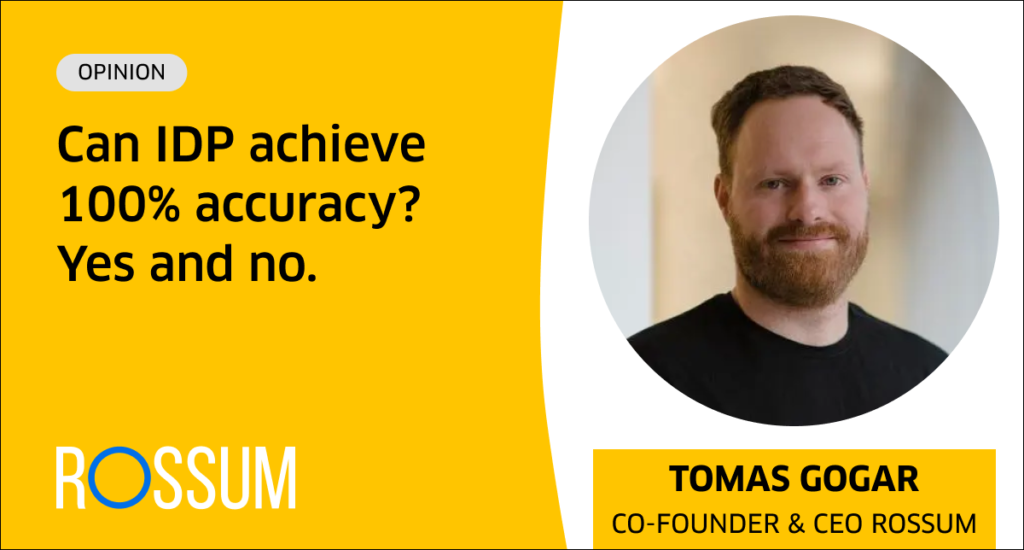Curious about what keeps experts, founders, CEOs and other decision-makers in the Intelligent Document Processing (IDP) space on their toes? Get food for thought on IDP-related topics from the industry’s leading minds.
In this opinion piece, Petr Baudiš, Co-Founder and CTO of Intelligent Document Processing (IDP) vendor Rossum, explains the issues that decision-makers in organizations often face when seeking IDP solutions – and what they should look out for on the road to success.
Imagine. As an innovative leader of your business unit, you launch an Intelligent Document Processing (IDP) solution to rave reviews in an enterprise back office. It transforms the way your team handles mountains of documents – bills of lading, invoices, and more. Employees love it, and the local operations team is thrilled by the efficiency gains and accuracy improvements. And your company moves its business relationships to the next level – thanks to fewer errors and exceptions when executing transactions, faster processing, and early visibility into the business.
Two years later, the solution is phased out — replaced by an outdated, more primitive system pushed through a global initiative designed to consolidate IT and operations across the whole enterprise. Predictably, it is back to square one, and your company faces poorer results, higher costs, less visibility, and employee churn. But no matter the reason, the end result is that your leadership failed to produce long-term results.
Why does this pattern repeat in many organizations?
Because local innovators too often lack a global follow-up plan – they do a rollout, and move on.
The Global Follow-up Plan
The plan is actually simple:
- Follow up, and push. Be an internal advocate for your work. Talk to HQ. Build momentum on the early wins. Persevere.
- ??? (Actually, not really. Just work with a vendor that will have your back all the way.)
- Profit.
The only thing is, as the Marines say — simple does not mean easy.
IDP Vendors for Going Global
To ensure that your solution isn’t just a local success story but a blueprint for enterprise-wide transformation, you need to work with the right vendor. First, it needs to be someone who isn’t a provider but a partner to you—a vendor who works with you strategically on expanding the solution and relentlessly focuses on value.
To know this partnership is going to work in practice to break through to global scale, think about two key ingredients in particular. The first is geographical versatility, the second is a sustainable IT approach.
IDP and Many-National Enterprises
Today’s enterprises aren’t just multinational; they’re “many-national.” Allow me to explain. Business operations in Fortune 500 companies stretch across an average of 70 countries, covering different languages, regulations, and compliance needs.
It’s not just the back office operations that are global—the consumers and the entire supply chain are. Building a product may require raw materials from Africa, components from Europe, and assembly in South East Asia, resulting in millions of transactions with suppliers worldwide. Not to mention the complexity of Electronic Data Interchange (EDI) and e-invoicing standards, which can vary wildly even within a single economic region like the EU.
Then there’s the issue of document variability. In some regions, up to 30% of documents contain handwritten notes. The sheer scale and variability are challenging enough without throwing in the constant churn of suppliers and vendors.
Simply put, IDP solutions for these environments must be as agile and scalable as the enterprises they enable.
Why Traditional IT Approaches Can’t Keep Up
Ironically, as the demand for automation and efficiency increases, the IT resources needed to support them are increasingly scarce. Deloitte reports that 46% of CIOs cite skill shortages as a major blocker for implementing new technologies. The shortage of skilled IT professionals, combined with the diverse needs of a global enterprise, has resulted in companies capturing only 25% of the savings they expected from digital transformations, according to McKinsey.
This resource bottleneck means traditional approaches to process automation often fail to deliver real, lasting results. Moreover, upending a centrally established solution with an innovative one is possible only when the IT cost difference helps justify the project.
Leadership Lies in The Steady Path
Leading a global change in your organization needs its share of patience. It’s not about scrapping all local efforts and replacing them with a grand, greenfield global rollout. Validating approaches through challenging pilots, then staging the rollout, and starting local is a great idea. The best proof is in achieved results, as long as you sell it on.
To support this path at every step, choose a vendor with the capacity to handle all languages and legal requirements, deliver reliable automation, and do it all with minimal IT involvement. In short, making the technology work for your needs, not vice versa.
With Generative AI, we finally have the technology to make this possible. Today’s advanced AI models are adaptable, scalable, and don’t require a legion of developers for deployment. They can process documents in all relevant locales and languages, handling complex requirements with fewer IT resources. New AI copilots — that are built with an underlying technology designed to support Large Language Models (LLMs) from day one — empower domain experts, not just IT specialists, to set up and manage workflows. This lowers the skills threshold needed, letting those closest to the business fine-tune and optimize processes without heavy IT intervention.
AI’s configurability also provides a safety net. These systems allow for thorough setup-time reviews, reducing risks like data inaccuracies or even targeted attack vulnerabilities, that might crop up in more ad hoc AI deployments.
Ready to Dive In?
The truth is, complexity and variability will always remain the de facto state of business transactions. No matter how much we consolidate or streamline, the world is too nuanced for simple fixes. That’s precisely why we started Rossum—not because the problem was easy, but because we believed in technology’s transformative potential to free humans from mundane, repetitive tasks. We’re here because someone needs to embrace the messiness of the real world and design tools that make it manageable.
For enterprises, the message is clear: Go global, or go bust. The stakes have never been higher. But the path forward doesn’t lie in rigid, top-down mandates. Instead, it requires a spirit of experimentation, a willingness to test new AI-driven innovations, and an openness to engage with all stakeholders—internal teams, external vendors, and even customers.
What does this mean in practice? First, it means adopting an agile mindset. AI is evolving fast, but that doesn’t mean waiting until it’s “perfect.” Pilot solutions in key regions. Analyze results. Scale strategically. Second, it means choosing partners who understand that AI isn’t magic — it’s a tool. Tools need thoughtful implementation, continuous refinement, and the flexibility to adapt to local conditions.
The plan is simple, but not easy. That’s because it is not always easy to spot the best vendor to partner with at the beginning, but also because the locally “best” solution may not always win in a large organization’s reality. But the outcomes you can achieve for your company if you make it through are almost magical — largely automated backoffices and zero-latency transaction execution.
It’s worth diving in and making the change a reality.

About the Author
Petr Baudis is a co-founder and CTO of Rossum, a SaaS deep tech startup with over $100M Series A venture funding that focuses on automating business-to-business transactional document processing using state-of-art AI technology. He serves on the board of the company and oversees its R&D and product development. In the past, Petr led multiple AI research and deep learning projects in academia as well as in commercial environments. His work was used by companies like Google DeepMind, Novartis, and Seznam.cz. Petr’s past exploits also include working with Linus Torvalds as one of the founding developers of the Git tool and leading many other open-source projects.
📨Get IDP industry news, distilled into 5 minutes or less, once a week. Delivered straight to your inbox ↓








